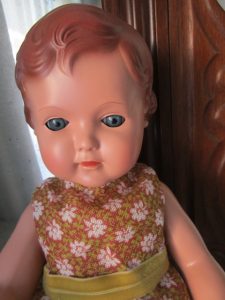Toda la oferta se selecciona siguiendo unos criterios de calidad de los materiales y de los acabados. Siempre se intenta servir la pieza con la máxima celeridad. Se ofrece la posibilidad de presupuestos de Restauración y/o de Conservación personalizados. Contáctame para más información.
Tienda
Celluloid Schildkröt 53 Doll
180,00€
Celluloid Schildkröt 53 Doll. It has articulated head, arms and legs. The eyes are original, pendulars and glass, vibrant facial coloration, ajar mouth, molded painted hair This doll arrived in my hands in perfect condition only the rubbers have been changed. It measures about 52 cm.
The body and the head have the drawing of a turtle inside a diamond and the mold number 53 . Mark attributed to Schildkröt.
The Schildkröt Brand
Established in Bavaria in 1873 by Friedrich Bensinger, the Reinische Gummi-und Celluloid Fabrik was the major producer of celluloid in Germany.
Schildkrote is the German word for turtle, and the company’s main trademark was a walking turtle encased in a diamond, which was molded on the doll necks and bodies like Celluloid Schildkröt 53 Doll
Therfore the mark is raised. In some cases the diamond is omitted, or the turtle is enclosed in a circle, square, oval, triangle, or hexagon. Other manufacturers of celluloid also used the trademark of a turtle therfore to represent durability. The raiser turtle-in-a-diamond was exclusive to the Rheinische Gummi und Celluloid -Fabrik.
The Celluloid
In the last quarter of the 19th century, celluloid began to compete with traditional materials used in doll making, such as biscuit, wood, paper, and cloth.
Because it was a versatile substance, made from pyroxylin (cellulose nitrates) and camphor, it was an inexpensive material and easy to produce.
It was mostly used extensively for doll making, as well as many household items, until the mid-1950s same Celluloid Schildkröt 53 Doll , when it was replaced by other plastics.
Celluloid was first developed and used for Hyatt Brothers dolls in New Jersey in the late 1860s. His company registered the name “celluloid” in 1869. Although the product was patented, the word celluloid is used to Often to describe all types of pyroxylin mixtures, regardless of manufacturer.
The manufacturing process of the celluloid dolls in the first place is to place the celluloid substance in its solid state in a two-piece metal mold. The second step was to introduce steam or hot air into the mold under pressure, this softened the celluloid adapting to the shape of the mold until the two halves were joined.
When it cools, it is removed from the mold and the doll is decorated.
You May be Interested in…
Envío gratuíto para pedidos superiores a 60€ (España peninsular).
In stock
Todos los envíos se realizaran en Correos de España dando el número de seguimiento. El envío puede tardar entre 2 a 8 semanas, podría ser que el envío se retrásese un poco más debido a los trámites aduaneros de cada país. Cualquier posible cargo de impuestos, tipo aranceles, va a cargo del destinatario. Para información sobre precios de envío consulta esta pàgina. Los embalajes se realizaran con elementos que amortiguan los golpes como espuma protectora, plástico de burbujas y una caja de cartón de embalaje. No se aceptan cambios, devoluciones ni cancelaciones.







